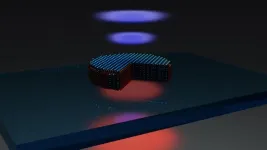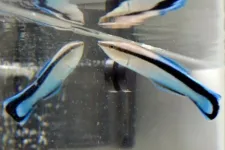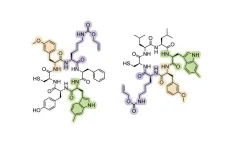(Press-News.org) Researchers at Chalmers University of Technology, in Sweden, have for the first time succeeded in combining two major research fields in photonics by creating a nanoobject with unique optical qualities. Since the object is a thousand times thinner than the human hair, yet very powerful, the breakthrough has great potential in the development of efficient and compact nonlinear optical devices. “My feeling is that this discovery has a great potential,” says Professor Timur Shegai, who led the study at Chalmers.
Photonic applications harness the power of light-matter interactions to generate various intriguing phenomena. This has enabled major advances in communications, medicine, and spectroscopy, among others, and is also used in laser and quantum technologies. Now, researchers at the Department of Physics at Chalmers University of Technology have succeeded in combining two major research fields - nonlinear and high-index nanophotonics – in a single disk-like nanoobject.
“We were amazed and happy by what we managed to achieve. The disk looking structure is much smaller than the wavelength of light, yet it's a very efficient light frequency converter. It is also 10,000 times, or maybe even higher, more efficient than the unstructured material of the same kind, proving that nano structuring is the way to boost efficiency,” says doctor Georgii Zograf, lead author of the article in Nature Photonics where the research results are presented.
A new fabrication with no loss of properties
Somewhat simplified, it is a combination of material and optical resonances with the ability to convert light frequency through crystal’s non-linearity that the researchers have combined in the nanodisk. In its fabrication, they have used transition metal dichalcogenide (TMD), namely molybdenum disulfide, an atomically thin material that has outstanding optical properties at room temperature. The problem with the material is however that it is very difficult to stack without losing its nonlinear properties due to its crystalline lattice symmetry constraints.
“We have fabricated for the first time a nanodisk of specifically stacked molybdenum disulfide that preserves the broken inverse symmetry in its volume, and therefore maintains optical nonlinearity. Such a nanodisk can maintain the nonlinear optical properties of each single layer. This means that the material's effects are both maintained and enhanced," says Georgii Zograf.
The material has a high refractive index, meaning that light can be more effectively compressed in this medium. Furthermore, the material has the advantage of being transferable on any substrate without the need to match the atomic lattice with the underlying material. The nano structure is also very efficient in localising electromagnetic field and generating doubled frequency light out of it, an effect called second-harmonic generation. It's a so-called nonlinear optical phenomenon, for example, similar to the sum- and difference-frequency generation effects used in high-energy pulsed laser systems.
Thus, this nanodisk combines extreme nonlinearity with high-refractive index in a single, compact structure.
A big step forward for optics research
“Our proposed material and design are state-of-the-art due to extremely high inherent nonlinear optical properties and notable linear optical properties – a refractive index of 4.5 in the visible optical range. These two properties make our research so novel and potentially attractive even to the industry,” Georgii Zograf says.
“It really is a milestone, particularly due to the disk's extremely small size. Second harmonic generation and other non-linearities are used in lasers every day, but the platforms that utilise them are typically on the centimetre scale. In contrast, the scale of our object is about 50 nanometers, so that's about a 100,000 times thinner structure,” says research leader Professor Timur Shegai.
The researchers believe that the nanodisk’s work will push photonics research forward. In the long term, TMD materials’ incredibly compact dimensions, combined with their unique properties, could potentially be used in advanced optical and photonic applications. For example, these structures could be integrated into various kinds of optical circuits, or used in miniaturisations of photonics.
“We believe it can contribute towards future nonlinear nanophotonics experiments of various kinds, both quantum and classical. By having the ability to nano structure this unique material, we could dramatically reduce the size and enhance efficiency of optical devices, such as nanodisk arrays and metasurfaces. These innovations could be used for applications in nonlinear optics and the generation of entangled photon pairs. This is a first tiny step, but a very important one. We are only just scratching the surface,” says Timur Shegai.
Illustration caption: Schematic of the optical experiment: Excitation near-infrared laser (red bottom one) - excites the nanodisk fabricated from the 3R-molybdenum disulfide flake, standing on a glass substrate. The quarter-cut-section of the disk schematically shows that incident laser excites optical resonances, that’s why we see red areas which represent higher density of electromagnetic field. This localisation alongside with the crystalline lattice broken inverse symmetry allow for effective conversion of red pump laser into blue light (doubled frequency).
Illustration credit: Chalmers University of Technology | Georgii Zograf
More about the research:
Combining ultrahigh index with exceptional nonlinearity in resonant transition metal dichalcogenide nanodisks was published in Nature Photonics, June 13 2024. It is written by Georgii Zograf, Alexander Yu. Polyakov, Maria Bancerek, Tomas J. Antosiewicz, Betül Küçüköz and Timur Shegai. The researchers are all active at the Department of Physics at Chalmers University of Technology, except for Bancerek and Antosiewicz who are active at the Faculty of Physics, University of Warsaw.
The work was performed in part at Myfab Chalmers and Chalmers Material Analysis Laboratory. Calculations were partially done at the Interdisciplinary Centre for Mathematical and Computational Modelling, University of Warsaw.
For more information, please contact:
Timur Shegai, Professor, Department of Physics, Chalmers University of Technology, timurs@chalmers.se, +46 (0)31 772 31 23
Georgii Zograf, Doctor, Department of Physics, Chalmers University of Technology, georgii.zograf@chalmers.se
END
Unique nanodisk pushing photonic research forward
2024-09-11
ELSE PRESS RELEASES FROM THIS DATE:
Century-old experiment secures beer and whiskey’s future
2024-09-11
Thanks to an experiment started before the Great Depression, researchers have pinpointed the genes behind the remarkable adaptability of barley, a key ingredient in beer and whiskey. These insights could ensure the crop’s continued survival amidst rapid climate change.
Grown everywhere from Asia and Egypt to Norway and the Andes mountains of South America, barley is one of the world’s most important cereal crops and has been for at least 12,000 years. As it has spread across the globe, random ...
Researchers improve search for cancer drivers
2024-09-11
PULLMAN, Wash. -- A computer algorithm can efficiently find genetic mutations that work together to drive cancer as well as other important genetic clues that researchers might someday use to develop new treatments for a variety of cancers.
Reporting in the journal Frontiers in Bioinformatics, a Washington State University-led team used a novel network computer model to find co-occurring mutations as well as other similarities among DNA sequence elements across several types of cancer. The model allows for easier searches for patterns in huge seas of cancer genetic data.
“This is a ...
Mirror, mirror, in my tank, who’s the biggest fish of all?
2024-09-11
What if that proverbial man in the mirror was a fish? Would it change its ways? According to an Osaka Metropolitan University-led research group, yes, it would.
In what the researchers say in Scientific Reports is the first time for a non-human animal to be demonstrated to possess some mental states (e.g., mental body image, standards, intentions, goals), which are elements of private self-awareness, bluestreak cleaner wrasse (Labroides dimidiatus) checked their body size in a mirror before choosing whether to attack fish that were slightly larger or smaller than themselves.
The ...
Scripps Research scientists expand the genetic alphabet to create new proteins
2024-09-11
LA JOLLA, CA—It’s a dogma taught in every introductory biology class: Proteins are composed of combinations of 20 different amino acids, arranged into diverse sequences like words. But researchers trying to engineer biologic molecules with new functions have long felt limited by those 20 basic building blocks and strived to develop ways of putting new building blocks—called non-canonical amino acids—into their proteins.
Now, scientists at Scripps Research have designed a new paradigm for easily adding non-canonical amino acids to proteins. Their approach, described in Nature Biotechnology on September 11, 2024, revolves around using ...
Breakthrough research sheds light on the hidden effects of stress on sperm
2024-09-11
A groundbreaking study led by researchers at the University of Colorado Anschutz Medical Campus reveals that stress-induced changes in sperm motility occur after a stressful event, rather than during it and improves sperm performance. The discovery is essential in understanding how stress impacts the reproductive process to improve fetal development outcomes.
The study was published today in Nature Communications.
Over the last five decades, there has been a notable decline in semen quality, which has coincided with environmental stressors. This new research identifies how stress affects the ability of ...
Throat problems could impair autonomic nervous system's ability to regulate blood pressure
2024-09-11
Throat problems could impair autonomic nervous system's ability to regulate blood pressure
Research suggests problems at junction between air and food passages may ‘overwhelm’ the Vagus nerve
Patients with throat problems were less able to regulate their blood pressure in a new study led by the University of Southampton.
The study published in JAMA Otolaryngology is the first to observe reduced baroreflex sensitivity in patients with throat symptoms.
The baroreflex is a crucial part of the autonomic nervous system which detects changes ...
Pandemic of homicide grief in global Black communities urgently needs a public health response
2024-09-11
The Centre for Research and Innovation for Black Survivors of Homicide Victims (The CRIB) is calling for decisive action to address the grief from homicide that is disproportionately affecting Black communities worldwide — and to tackle the root causes of homicide that impact this population.
In a paper published in the journal Homicide Studies, University of Toronto social work professor Tanya Sharpe and colleagues argue that the prevalence and spread of homicide grief — the grief that follows the ...
How do human and dog interactions affect the brain?
2024-09-11
During social interactions, the activity of the brain’s neurons becomes synchronized between the individuals involved. New research published in Advanced Science reveals that such synchronization occurs between humans and dogs, with mutual gazing causing synchronization in the brain’s frontal region and petting causing synchronization in the parietal region. Both regions are associated with attention.
The strength of this synchronization increased with growing familiarity of human–dog pairs over 5 days, and tests indicated that the human is the leader while ...
Can green finance effectively reduce carbon dioxide emissions while promoting economic growth?
2024-09-11
New research published in Business Strategy and the Environment based on information from G7 countries demonstrates that green finance—loans, investments, and incentives that support environmentally-friendly projects and activities—can reduce carbon dioxide emissions. Also, data indicate that investments in green projects are profitable.
The study found that G7 countries' environmental conditions have been negatively impacted by economic development; however, there are advantages of green finance solutions for economic growth.
The study’s investigators ...
Are there racial differences in the use of opioids after returning home from hospitalizations for hip fractures?
2024-09-11
In an analysis of information on 164,170 older adult Medicare beneficiaries who were hospitalized for hip fractures, a similar proportion of Black and white beneficiaries used opioids after they were discharged and returned to the community, but Black beneficiaries consistently received lower doses of the pain medications.
In the study published in the Journal of the American Geriatrics Society, investigators observed that on average Black beneficiaries received the equivalent of around 250 fewer milligrams ...




